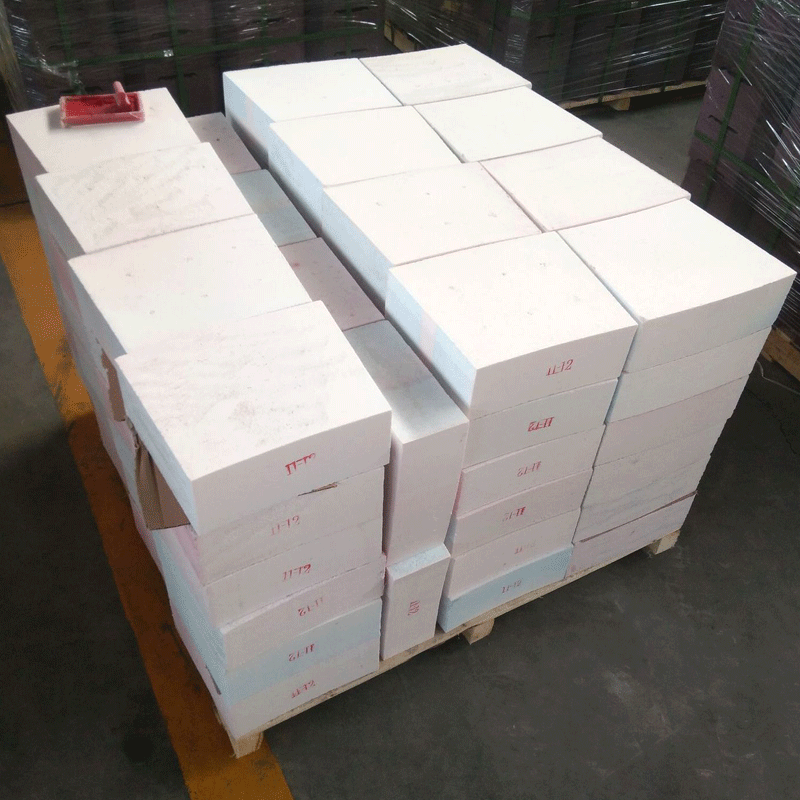
Corundum bricks are mainly used in iron-making blast furnaces and blast furnace hot blast furnaces, refining furnaces outside steel-making furnaces, sliding water heaters, glass melting furnaces and petrochemical industrial furnaces, etc.
Corundum bricks for glass melting furnace
Sintered corundum bricks refers to a corundum refractory product made of sintered alumina clinker with an alumina content of 70%-90%. Gas-bonded corundum bricks has high melting point, stable performance at high temperature, good mechanical strength and wear resistance at room temperature and high temperature, and excellent resistance to metal corrosion and redox resistance. The production process of sintered corundum bricks is to crush the sintered corundum bricks to 3mm coarse particles and some fine powders less than 0.074mm, some add a small amount of clay and other binders for mixing, and use a high-pressure friction brick press or hydraulic press to form. After drying, it is put into high temperature and fired. Generally, sintered corundum bricks with higher purity have a firing temperature of 1750-1800 °C. If a small amount of clay or additives is added, the firing temperature can be 1600~1700℃.
|
project |
index |
|
|
WGZ-80 |
WGZ-80 |
|
|
Al2O3%≥ |
80 |
83 |
|
Fe2O3%≤ |
1.0 |
1.0 |
|
Apparent porosity%≤ |
15 |
13 |
|
Bulk density%(g/cm3)≥ |
3.1 |
3.2 |
|
Cold compressive strength/MPa≥ |
130 |
150 |
|
molten iron erosion index%≤ |
1.5 |
1.0 |
|
Slag resistance%≤ |
10 |
8 |
|
Air permeability≤ |
0.5 |
0.5 |
|
Average pore size um≤ |
0.5 |
0.3 |
|
Alkaline resistant%≤ |
10 |
10 |
Sintered corundum bricks have been widely used as lining materials in petrochemical thermal devices with high temperature, high pressure, chemical erosion and severe mechanical wear. The equipment achieves the purpose of large load, long cycle, low energy consumption and low cost.
The heavy part of the raw materials for the chrome zirconium corundum composite brick is sintered tabular corundum, high-purity chromium oxide, high-purity zircon, and Guangxi white cement.As the main raw material, the light part of the raw material is made of 47 mullite, kyanite, floating beads and coke gemstones as the main raw materials. During molding, a separator is set in the middle of the mold, and heavy materials and light materials are added at both ends. After high pressure molding , finished products made of high temperature sintering.
The heavy parts of the chrome-zirconium mullite composite bricks are made of high-purity sintered mullite, high-purity chromium oxide, high-purity zirconia, and Guangbai mud as the main raw materials, and the light part of the raw materials are made of 47 mullite, kyanite, Bleaching beads, coke gemstones and Guangxi white mud are the main raw materials
Chrome corundum brick refers to corundum refractory products containing Cr2O3. At high temperature, Cr2O3 and Al2O3 form a continuous solid solution, so the high temperature performance of chromium corundum products is better than that of pure corundum products. Chromium corundum products are widely used, and the content of Cr2O3 is mostly in the range of 9% to 15%.
Brown corundum refractory brick is made of fused corundum as the main raw material. It is formed by high pressure and fired at high temperature. It has high thermal shock stability, low porosity, low expansion, good resistance to melt vapor and gas erosion, and excellent oxidation resistance. Dimensionally accurate advantages.
It is widely used in the lining of the kiln working face which is in direct contact with the flame, and has become one of the research hotspots in recent years.
Magnesia chrome bricks are refractory products with magnesia (MgO) and chromium trioxide (Cr2O3) as the main components, and periclase and spinel as the main mineral components. The main raw materials for the manufacture of magnesia-chrome bricks are sintered magnesia and chromite.
The heavy parts of the chrome-zirconium mullite composite bricks are made of high-purity sintered mullite, high-purity chromium oxide, high-purity zirconia, and Guangbai mud as the main raw materials, and the light part of the raw materials are made of 47 mullite, kyanite, Bleaching beads, coke gemstones and Guangxi white mud are the main raw materials
Castables Refractory for cement kiln Castables for cement kilns are special refractory castables for cement kilns. In my country, the new dry-process cement technology is developing rapidly, and the design and brick shape of PC and SP kilns are also very complicated. In order to adapt to this situation, our factory has developed a series of new refractory castables to replace the traditional refractory materials. Practice has proved that it is more suitable to use castables in parts with complex structure and kiln body deformation. Castables are also suitable for coolers, preheaters, precalciners, kiln door covers, tertiary air ducts and other parts that require thermal insulation. Its varieties include alkali-resistant castables, high-alumina and corundum castables, heat-insulating castables, and steel fiber reinforced refractory castables. Gongyi Yuying Refractory Co., Ltd. operates: castables for cement kilns, prefabricated blocks, low cement castables, refractory mud, refractory ramming materials, corundum castables, refractory castables, steel fiber castables, steel jade castables, Refractory plastics, high alumina castables, wear-resistant castables, plastics, castables, clay castables, refractory castables manufacturers, the company has 160 employees, including 12 senior professional and technical personnel, with an annual production capacity of 60,000 tons , has light and heavy material production lines, various production, testing and testing equipment, including 10 sets of 400-ton to 1,000-ton series forming presses, two (148 meters long and 118 meters long) high temperature tunnel kiln . Castables are also suitable for use in some parts of coolers, preheaters, precalciners, kiln door covers and tertiary phoenixes. Suitable thermal insulation castables can be used in preheaters of cement kilns and other parts that require thermal insulation. The main castables used in cement kilns are: index Alkali resistant castable High alumina castable High Alumina Steel Fiber Castable High strength mullite castable Silicon carbide anti-skin castable GT-13NL G-16 GF-16 G-20G GC-13H Al2O3%≥ 35 65 65 65 55 SiO2+SiC%≥ - - - - 35 Bulk densityg/cm3≥ 2.10 2.5 2.5 2.60 2.5 Cold pressed strengthMpa≥ 110℃×24h 60 80 80 80 80 1100℃×3h 60 80 80 90 100 Flexural strengthMpa≥ 110℃×24h 6 8 9 8 8 1100℃×3h 6 8 9 9 10 Rate of change of line after burning 1100℃×3h ±0.5 ±0.3 ±0.3 ±0.3 ±0.3 1. Alkali resistant castable Experiments show that the alkali pouring material has excellent alkali resistance much better than ordinary clay or high alumina pouring material. Ordinary and low-cement alkali-resistant castables have been successfully used in double-layer structural linings for preheater roofs, cones, tertiary air ducts, etc., where shaped bricks are not suitable. The low-cement alkali-resistant pouring material can also be used in the rear kiln mouth, cooler and kiln door cover. 2. High alumina and corundum castables High alumina and corundum castables for cement kilns include low cement and ultra-low cement castables, high strength corundum castables, etc. Calcined bauxite and cut jade are used as aggregates in the castable. Low cement and ultra-low cement type high alumina castables can be used in front and rear kiln mouths, chain belts, kiln door covers and cooler side walls. 3. Insulation casting section The heat-insulating castables for cement kilns include ordinary heat-insulating castables, high-strength heat-insulating castables, and ordinary and low-cement alkali-resistant heat-insulating castables. Usually high alumina cement is used as a binder in the castable. Ordinary heat-insulating castables use expanded perlite, expanded vermiculite and waste light bricks as aggregates. High-strength heat-insulating castables use refractory clay ceramsite, fly ash ceramsite, shale ceramsite, etc. as aggregates. Alkali-resistant and heat-insulating castables use alkali-resistant lightweight aggregates. Ordinary heat-insulating castables and their prefabricated blocks can be used as heat-insulating villages in double-layer structural linings of coolers, preheaters, calciners, kiln door covers and tertiary air ducts; high-strength heat-insulating castables and their prefabricated Blocks are available as single-layer linings in the neck and disintegration zones of conventional kilns. Ordinary and low-cement alkali-resistant and heat-insulating castables can be used in preheaters in small and medium-sized kilns and other parts that require alkali-resistant heat insulation. 4. Steel fiber reinforced refractory castables Adding steel fiber can improve the dismantling strength of the castable, and greatly improve the thermal shock resistance, impact resistance and wear resistance of the castable. Our company has carried out a lot of systematic research on steel fiber reinforced refractory castables, and developed a series of steel fiber reinforced refractory castables.



